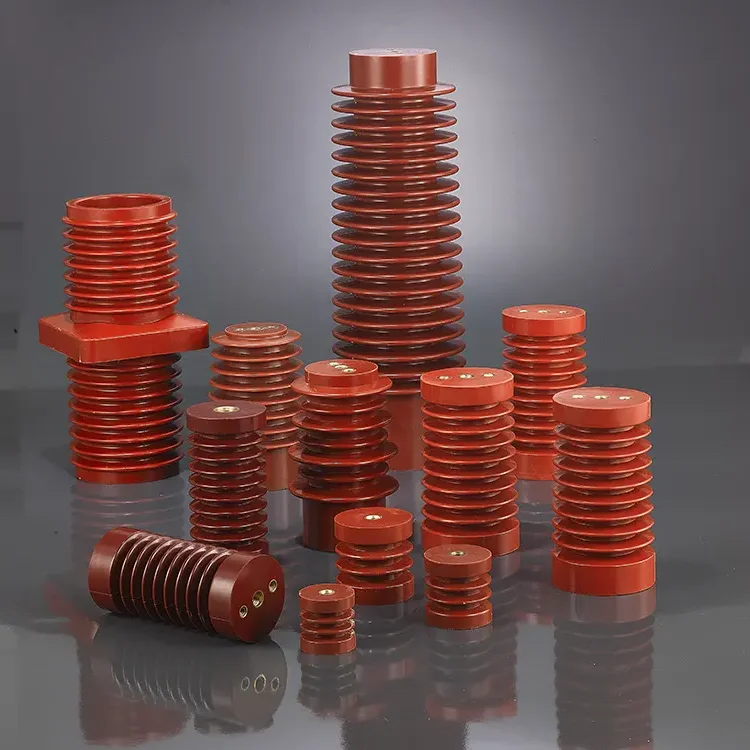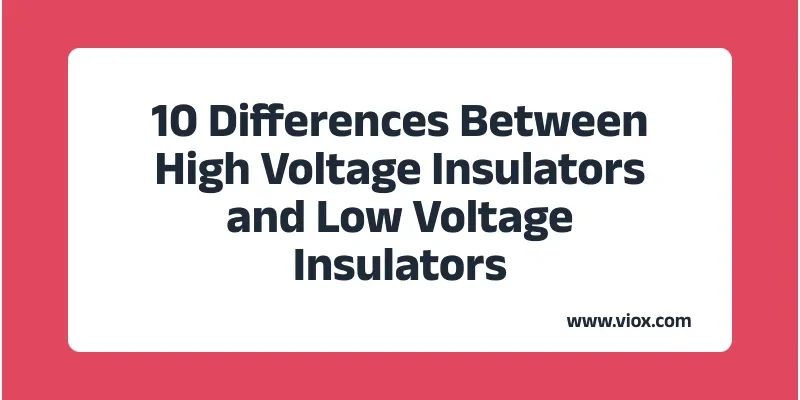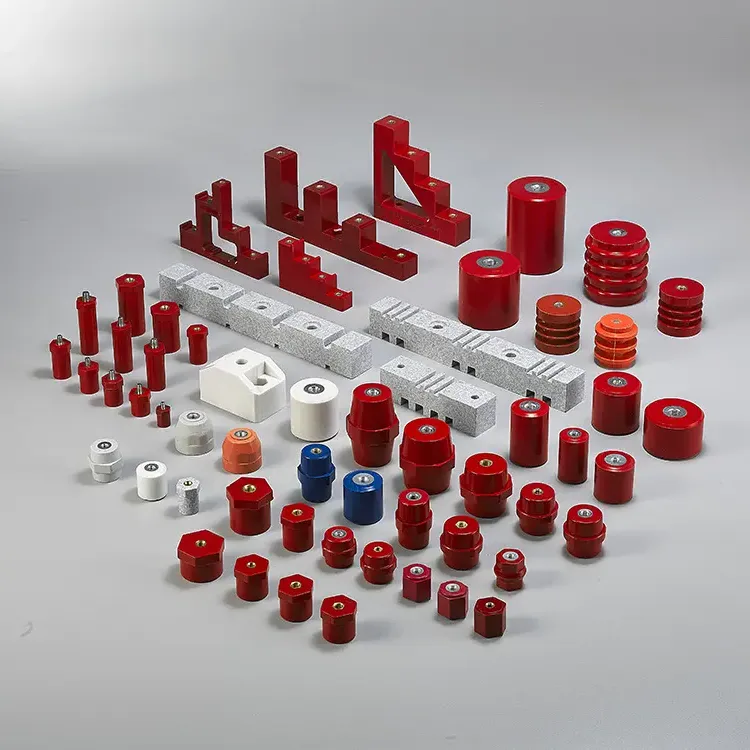Kõrge- ja madalpinge isolaatorite erinevuste mõistmine on elektritööstuse spetsialistide jaoks väga oluline. Need isolaatorid tagavad elektrisüsteemide ohutuse ja tõhususe. Kõrgepingeisolaatorid tulevad toime äärmuslikes tingimustes ja suurte elektriliste koormustega, samas kui madalpingeisolaatoreid kasutatakse igapäevaselt elamutes ja äritingimustes. Selles artiklis tuuakse välja kümme peamist erinevust nende kahe isolaatoritüübi vahel, keskendudes nende omadustele, materjalidele ja konkreetsetele rakendustele.
Kõrgepinge isolaatori määratlus

Kõrgepingeisolaatoritel on mitu põhiomadust, mis muudavad need elektriülekandesüsteemides oluliseks. Neil on suurepärane dielektriline tugevus, tavaliselt vahemikus 10 kuni 30 kV/mm, mis takistab elektrilist läbikukkumist. Nende keerulised konstruktsioonid sisaldavad sageli mitut shedi või ketast, et suurendada roomavahemaad ja vältida väljalülitusi. Need isolaatorid on valmistatud vastupidavatest materjalidest, nagu kõrge puhtusastmega keraamika, karastatud klaas või täiustatud komposiitmaterjalid, mis on väga vastupidavad keskkonnakahjustustele. Need on konstrueeritud töötama usaldusväärselt karmides välistingimustes, sealhulgas äärmuslikes temperatuurides, reostuse ja niiskuse tingimustes.
Lisaks sellele on kõrgepingeisolaatorid kavandatud kandma suuri mehaanilisi koormusi, säilitades samal ajal elektrilise isolatsiooni. Paljud neist isolaatoritest sisaldavad spetsiaalseid katteid või töötlemisviise, et parandada nende toimivust saastunud keskkonnas. Need omadused tagavad üheskoos elektriülekandesüsteemide usaldusväärse ja tõhusa toimimise keerulistes tingimustes.
Madalpinge isolaatori määratlus
Madalpingeisolaatorid on seadmed, mis on spetsiaalselt ette nähtud juhtmete elektriliseks isoleerimiseks ja mehaaniliseks toestamiseks süsteemides, mis töötavad alla 1000 volti pingel. Nende esmane ülesanne on vältida elektrilekkeid, tagades voolu voolamise ettenähtud teel, kaitstes samal ajal seadmeid ja säilitades ohutuse. Need isolaatorid on elamu-, kaubandus- ja tööstuslike elektrisüsteemide lahutamatu osa, kus neid kasutatakse sellistes rakendustes nagu juhtmestik, lülitid ja jaotuskilbid.
Madalpinge isolaatorite põhiomadused on kõrge dielektriline tugevus, mis takistab elektrilist läbilööki, mehaaniline vastupidavus füüsilistele pingetele ja vastupidavus keskkonnateguritele, nagu niiskus või kerged kemikaalid. Need on tavaliselt valmistatud sellistest materjalidest nagu portselan, klaas, epoksüvaik või polümeerid, nagu nailon ja ABS, ning need on kavandatud lihtsa paigalduse ja kuluefektiivsuse tagamiseks. Nende lihtsam konstruktsioon võrreldes kõrgepingeisolaatoritega peegeldab nende rolli vähem nõudlikes keskkondades.
Siin on 10 peamist erinevust
1.Voltage Käsitlemisvõimsus
Pingevahemik on oluline tegur, mis eristab kõrgepingeisolaatoreid madalpingeisolaatoritest. Kõrgepingeisolaatorid on mõeldud kasutamiseks üle 1 kV pingega, mõned neist on võimelised taluma pinget kuni 1000 kV või rohkem ülikõrgepingesüsteemides. Need isolaatorid on hädavajalikud elektrienergia ülekandmisel pikkade vahemaade taha ja alajaamades, kus elektripinge muundatakse. Seevastu madalpinge isolaatorid on spetsiaalselt projekteeritud alla 1 kV töötavate süsteemide jaoks, mida tavaliselt kasutatakse elamutes ja väikestes ärirakendustes.
2. keerukus disainis
Kõrgepingeisolaatorite konstruktsiooni keerukus peegeldab nende vajadust tulla toime äärmusliku elektrilise koormuse ja keskkonnateguritega. Nendel isolaatoritel on tavaliselt mitu ketast või kuuri, mis on sageli paigutatud jadade või ahelatena, et suurendada üldist sõiduulatuskaugust ja vältida elektrivalgustuse tekkimist. Hoidiku profiil, sealhulgas sellised tegurid nagu vahekaugus ja läbimõõt, mõjutavad oluliselt reostuse ülevoolutõhusust.
Seevastu madalpinge isolaatorite puhul kasutatakse lihtsamaid, üheosalist konstruktsioone, mis sobivad nende vähem nõudlikele rakendustele. Need isolaatorid on sageli valmistatud sellistest materjalidest nagu plastik, portselan või kummi ning need on mõeldud lihtsaks paigaldamiseks kontrollitud keskkondadesse, näiteks kodudesse ja väikeettevõtetesse.
3.Materiaalse koostise erinevused
Kõrgepingeisolaatorid tuginevad kõrgetasemelistele materjalidele, nagu kõrge puhtusastmega keraamika, karastatud klaas ja komposiitpolümeerid, et taluda äärmuslikke elektrilisi ja keskkonnaalaseid pingeid. Need materjalid pakuvad suurepärast dielektrilist tugevust, mehaanilist vastupidavust ja saastekindlust. Keraamilised isolaatorid on kaetud sileda glasuuriga, mis eraldab vett ja takistab reostuse kogunemist.
Seevastu madalpinge isolaatorites kasutatakse tavaliselt kuluefektiivsemaid materjale, nagu tavaline keraamika, plastilised polümeerid ja kummi. Need materjalid tagavad piisava isolatsiooni madalama pinge rakenduste jaoks, seades samas esikohale taskukohasuse.
4.Environmental Vastupidavuse kontrast
Kõrgepingeisolaatorid on konstrueeritud nii, et nad peavad vastu karmidele välistingimustele, sealhulgas äärmuslikele temperatuuridele, UV-kiirgusele, saastumisele ja niiskusele. Need isolaatorid sisaldavad sageli spetsiaalseid katteid, näiteks ruumitemperatuuril vulkaniseerivat silikoonkummi (RTV-SiR), et parandada väljalülituspinget saastunud tingimustes.
Madalpinge isolaatorid seevastu on mõeldud rohkem kontrollitud siseruumides kasutamiseks ja on vähem keskkonnastressi all. Nad töötavad temperatuurivahemikus -40 °C kuni 130 °C ja ei vaja samasugust kaitset UV-kiirguse või saaste eest.
5.Paigaldamise keerukuse erinevused
Kõrgepingeisolaatorite paigaldusprotsess on keeruline ja spetsialiseeritud ülesanne, mis nõuab raskeveokit ja kvalifitseeritud spetsialiste. Nende isolaatorite paigaldamiseks kõrgetele ülekandetornidele või elektriliinidele on sageli vaja kraanasid, redeleid ja spetsiaalseid tööriistu.
Seevastu madalpinge isolaatorite paigaldamine on tunduvalt lihtsam ja kättesaadavam. Neid isolaatoreid saab sageli paigaldada otse kaablitele või seadmetele minimaalsete tööriistadega, mis muudab nende paigaldamise kiiremaks ja üldtehnikutele jõukohaseks.
6.Hooldus Sageduskontrast
Kõrgepingeisolaatorid vajavad sagedast professionaalset kontrolli ja hooldust, sest nende roll elektriülekandes on kriitiline ja nad puutuvad kokku karmide keskkonnatingimustega. Regulaarne puhastamine on oluline, et eemaldada saasteained, mis võivad põhjustada väljalülitusi ja elektririkkeid.
Seevastu vajavad madalpinge isolaatorid minimaalset hooldust, enamiku rakenduste puhul piisab aeg-ajalt toimuvast visuaalsest kontrollist ja puhastamisest. Need isolaatorid võivad enne väljavahetamist vastu pidada mitu aastakümmet.
7.Hinnavahe ja tegurid
Kõrgepingeisolaatorite hinnad on oluliselt kõrgemad tänu nende täiustatud materjalidele, keerukatele tootmisprotsessidele ja rangetele sertifitseerimisnõuetele. Nendes isolaatorites kasutatakse spetsiaalset keraamikat, komposiitmaterjale või karastatud klaasi, mis on konstrueeritud nii, et need taluvad äärmuslikke elektrilisi pingeid ja keskkonnatingimusi.
Seevastu madalpinge isolaatorites kasutatakse odavamaid materjale, lihtsamaid konstruktsioone ja vähem nõudlikke tootmismeetodeid, mille tulemuseks on hinnaerinevus, mida võimendavad paigaldusseadmed ja hooldusvajadused.
8.Transmissiooni vahemiku erinevused
Kõrgepingeisolaatorid on olulised kaugelektri ülekandmiseks, võimaldades elektrienergia tõhusat transportimist sadade kilomeetrite pikkuse vahemaa tagant elektrijaamadest alajaamadesse. Need isolaatorid toetavad ülekandeliinid, mille pinge ulatub 100 kV kuni üle 1000 kV.
Seevastu madalpingeisolaatoreid kasutatakse kohalikes jaotusvõrkudes, tavaliselt mõne kilomeetri kaugusel lõpptarbijatest. Neil on oluline roll elektrienergia turvalisel jaotamisel naabruses asuvatest trafodest üksikutesse hoonetesse.
9.Dielektrilise tugevuse võrdlus
Kõrgepinge isolaatoritel on suurepärane dielektriline tugevus, mis tavaliselt ulatub 10-30 kV/mm, et taluda intensiivseid elektrivälju ilma läbipõlemiseta. Seevastu madalpinge isolaatoritel on nende rakenduste jaoks piisav dielektriline tugevus, mis on tavaliselt vahemikus 3 kuni 12 MV/m.
Dielektrilise tugevuse erinevus peegeldab erinevaid kasutusnõudeid.
10.Ohutusfunktsioonid
Kõrge- ja madalpinge isolaatorite erinevad rollid ja väljakutsed peegeldavad elektrisüsteemide erinevaid nõudeid kogu elektrijaotuse ahelas. Kõrgepinge isolaatorid peavad säilitama isolatsiooni terviklikkuse pikkade vahemaade vältel, puutudes kokku reostuse, niiskuse ja UV-kiirgusega. Seevastu madalpinge isolaatorid keskenduvad ohutu ja usaldusväärse isolatsiooni tagamisele alla 1000 V pingete puhul kontrollitud keskkonnas.



